 One Click...
One Click...
to all things local!
Single G
This memorial is located at the corner of North Green Street and West Parkway Drive in Cambridge City, Indiana. It honors a local legend, the harness race horse Single G.
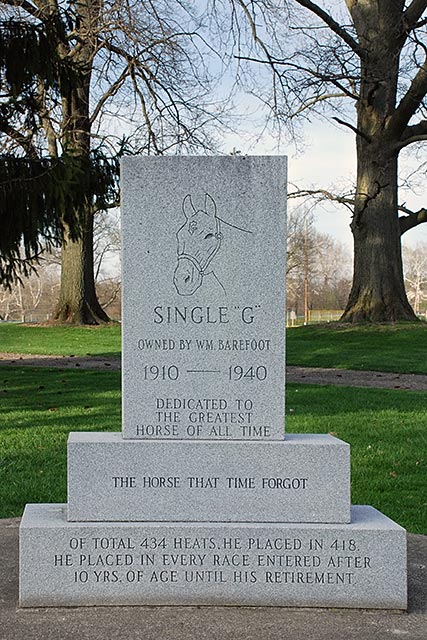
Photo taken April 6, 2010
-
For more information about "Single G", visit your local library and ask for "Single G: the Horse That Time Forgot" by Marie Hill. (Call #798H64)
-
Mural in the Cambridge City, Indiana Post Office, featuring Single G
Excerpt from the Cambridge City Centennial Celebration book:
The horse named Single G (named for the white G mark on his forehead) was foaled April 4, 1910 to sire, Anderson Wilkes and dam, Little Gyp. The "horse of firsts" was owned by W.B. Barefoot of Cambridge City, Ind.
Single G took part in 434 heats, winning 262 and placing in 418 heats. He is the only pacer in the history of harness racing to win over $100,000 in contested races – winning in 14 years a total of $121,125.
In Toledo, Ohio, in 1918, he was the first pacer to win a race in which three consecutive heats were all paced in 2:00 or better. In Atlanta, Ga., in 1920, he was the first horse to win a race with three consecutive heats averaging 2:00 or better.
He was the first horse to pace two heats in 1:59 or better in the same race. In the 1923 season in Syracuse, N.Y., Single G paced the first heat in 1:58 ½ and returned to pace the third heat in 1:58 ¾.
Single G retired from active racing in 1927 in Centerville, Ind. In retirement he became the first horse with a record of 2:00 or better to sire a horse to make a record of 2:00 or better with Dick Reynolds' 1:59 ¼. In addition Single G produced 34 standard performers to the close of the 1935 season, others being Walter Anderson with 2:01 ½, Doctor H with 2:01 ¾, Sonny Boy with 2:02, Nancy G with 2:04 ¼, Unity with 2:04 ¾, Maude G with 2:05 and 17 other horses in the 2:10 list.
Records
- He won 99 contested races, some going five heats.
- Won 264 heats out of 436 raced – placing in 418 of the races.
- Placed 1st in 264 heats.
- Placed 2nd in 88 heats.
- Placed 3rd in 37 heats.
- Paced 134 heats in 2:05 or better.
- Paced 117 heats in 2:04 or better.
- Paced 84 heats in 2:03 or better.
- Paced 54 heats in 2:02 or better.
- Paced 32 heats in 2:01 or better.
- Paced 13 heats in 2:00 or better.
(Special thanks to the Cambridge City Public Library for their assistance in gathering this information!)
The Horse We Shouldn't Forget
by Dean Hoffman
April 7, 2010------------Columbus, OH ---
This past Sunday was not only Easter Sunday but it was also the centennial of Single G, one of the most beloved horses in the lore of harness racing. The remarkable pacer was foaled April 4, 1910.
Single G is known by his reputation as "The Horse That Time Forgot." Just as time heals all wounds (or most of them), time also causes us to forget the harness heroes of the past as new champs come marching down the homestretch to win glory.
Single G is one of those rare horses whose reputation is untarnished by time. He may not come up in everyday conversation these days, but I'll betcha that you can mention the name Single G on the backstretches of most harness tracks and you'll get some measure of recognition.
Much of that may be due to the book about Single G written by Marie Hill, one of the pacer's staunchest supporters. I recently told Marie that when I was in Paris in late January on the Prix d'Amerique tour, I attended an auction of trotting books and art. Her book on Single G brought a winning bid of 55 Euros ($73.50). I don't know what European buyer felt compelled to invest in a book on a pacer virtually unknown in Europe but it speaks well for Single G's enduring fame.
As I recall, when a group of harness veterans were polled around 1950 to name the best pacers of the preceding half-century, they picked Single G on top, followed by Dan Patch and Billy Direct.
Single G raced for 14 consecutive seasons, making his final appearance on the Grand Circuit at the North Randall track in Cleveland at age 16. He raced free-legged, of course, as was customary in that era.
He outlived several of his trainer-drivers. Curt Gosnell raced him in 1915 and into 1916 before the horseman died as a result of a track accident. Fred Jamison had raced him early in his career and got him back at age eight, but then Jamison took sick and died. The driver most associated with Single G was Ed Allen, but even he broke his arm one summer and Single G had to be steered by various reinsmen.
It really made no difference who sat in the sulky behind Single G. He even survived eating an apple that had been poisoned and given to him by some backstretch bum. He missed a few races due to illness, but rallied back to win again.
Single G won more than $100,000 in races. When he retired in 1926, he was the only pacer to win more than $100,000 in races.
He was the first horse ever to pace faster than 1:59 twice in the same race. That took place in Syracuse when he took his mark of 1:58-1/2 and 1:58-3/4. (Keep in mind that even the great Dan Patch never paced faster than 1:58 "in the open" and that was in a time trial, not a race.) By the way, Single G took his mark at age 13.
He paced over the half-mile track in Des Moines in 2:01, the fastest ever, and a record not lowered for many years.
He won a dozen heats in 2:00 or faster, a remarkable total for the 1913-26 period. He won 54 heats in 2:02 or faster.
Everything he did was remarkable. When Single G retired, the Associated Press sent out a story that was picked up by major newspapers around America.
Single G's greatest days were his racing days as his breeding career in Indiana left little impact. He sired two horses in the "charmed" 2:00 list: the stallion Dick Reynolds p,1:59-1/4 and the good free-legged mare Single Stine p,2:00.
Single Stine had a successful breeding career with a dozen foals, half by Chief Counsel and the other half by his brother King's Counsel. Her daughter Miss Single Star took a mark of 1:59.1 in 1960 when no mare had ever paced faster than 1:56-3/4. Miss Single Star was a successful producer for many years, as was Still Waters, another Single G mare that contributed some good pacers to the breed.
Author Marie Hill was not the only devotee of Single G. Dorothy Rose of Spiceland, Indiana was perhaps his most fervent fan and she and husband Ralph kept alive a male line from Single G after all other male descendents of The Horse That Time Forgot had been assigned to the discard pile.
They faithfully bred mares to Clifton Boy, an unraced 1982 foal who was intensely inbred. His sire and dam were full siblings and both shared Single G as their great-grandsire.
The Roses were happy campers indeed in 1999 when Fairyfast, a male line Single G pacing mare by Clifton Boy, got a 1:58.4f mark. Demonstrating the characteristic Single G toughness, Fairyfast made 341 starts in her career but earned only $76,611.
The Roses raced and stood Mike's In Style, a brother to Fairfyfast, in an attempt to preserve the Single G male line, but he got only five foals and never sired a record performer.
The male line from Single G may be virtually extinct, but harness racing should never forget The Horse That Time Forgot.
Editor's Note: The views contained in this column are that of the author alone, and do not necessarily represent the opinions or views of the United States Trotting Association.
Republished with Permission Courtesy of USTA newsroom
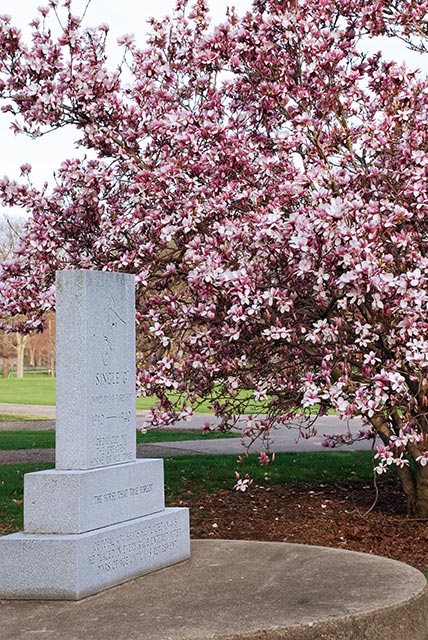
Summer Means County Fairs
by Carolyn Lafever
July 5, 2005, Lifestyles Magazine, Palladium-Item
Warm, sunny weather, flowers and leafy trees urges one to spend time outdoors. Summer also means meeting with friends and neighbors at county fairs.
Wayne County, Indiana has a large fairground on Salisbury Road, just west of Richmond. Nearly every summer since 1851, there has been a Wayne County (agricultural) Fair somewhere in the county. This year (2005) the fair is July 8 - 14.
In 2001, a historical exhibit was placed in the 4-H building to commemorate the 150 years of the fair. Each year since, the Alliance of Wayne County Museums has exhibited something about the history of Wayne County. This year, the exhibit will feature the famous Wayne County race horse of the early 20th century, Single G.
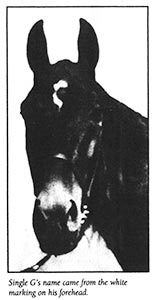
Single G was born on the farm of Lawrence D. Commons near Centerville in 1910. The cold did not have a distinguished blood line and in the first couple of years of his life, not much was expected of him. His mother was Little Gyp, owned by William Barefoot of Cambridge City. She had shown promise as a racer until an accident to her hip. This ended any hope of racing but she was saved from being shot because Mrs. Commons' fondness for the animal.
Later, Little Gyp was bred to a fine horse named Anderson Wilkes, owned by Commons. His best racing time was a poor 2:22 for the mile. However, their colt was to become one of Indiana's horse racing legends. The young colt was given the name, Single G, because of a mark on his forehead which clearly resembled the letter "G".
Lawrence Commons died in 1912 when Single G was almost two years old. To help settle the Commons' estate, Barefoot offered the horse for sale at the Lackey Horse Sale in March of 1912. There was not much interest in the horse, especially after he was unruly and broke away from the handlers during the auction. The horse was finally sold to H. S. Beard of Cambridge City for $275. It appears that Beard purchased the horse for Mr. Barefoot who was half owner of Single G. Barefoot didn't want to bid up the horse to protect his own haft interest.
To compare prices of other Commons & Barefoot horses sold at the same sale, a horse named Grace D. sold for $3,150. Grace D held the world's record for three year old pacers with a clocking of 2:10 1/4.
Single G began his harness racing career as a pacer in 1913 in Terre Haute. Harness racing is a horse race between people riding in sulkies behind horses that are either trotting or pacing. Over his 14 year racing career, he entered 1,954 races, won 98 and placed second 33 times, third 14 times and fourth place three times. Only two races did he finish below fourth.
In 1950, ten years after his death, a poll was conducted by a horseman's magazine and Single G was named the "pacer of the first half century." A memorial monument to this remarkable horse is in Creitz Park in Cambridge City.
Horse racing was a big part of Agricultural Fairs when they began in the early 1800s. An exception was one of Wayne County's early fairs held on the Benjamin B. Beeson farm near the small town of Dalton. The Dalton Fair was established in 1880. A county fair was being held at Centerville and critics of the fair felt it was not fair to residents of Western Wayne County. It must be remembered that in horse and buggy days, a trip to Centerville from Hagerstown would take several hours to attend or bring stock and other items for exhibit.
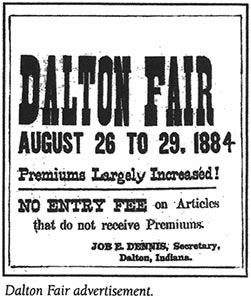 A
stock ring was built for the Dalton Fair, but it was only for
showing the animals. The men running the Dalton Fair were
primarily Friends (Quakers) who did not approve of horse racing and
gambling. In 1889, some of the newer members of the fair board
wanted a larger and more exciting fair. They wanted to move
the fair to Hagerstown and include a horse racing track. This
was to spell the demise of the Dalton Fair in a couple of years.
A
stock ring was built for the Dalton Fair, but it was only for
showing the animals. The men running the Dalton Fair were
primarily Friends (Quakers) who did not approve of horse racing and
gambling. In 1889, some of the newer members of the fair board
wanted a larger and more exciting fair. They wanted to move
the fair to Hagerstown and include a horse racing track. This
was to spell the demise of the Dalton Fair in a couple of years.
The Wayne County Fair at Hagerstown began in 1890. One of the main attractions was the new half-mile race track. A large covered spectators stand made for comfortable seating during the races. The fair was a great success and drew large crowds. It continued to do well but in 1890 a group of men from Richmond decided to build a race course and fairgrounds for that city. The site selected was on the Augustus Scott farm. The grounds became known as the old Driving park. It was located on what is now the south and western part of the Hayes Regional Arboretum in east Richmond (2010 - now Kohl's/Menards shopping center -editor). The site was convenient to the heavily traveled National Road.
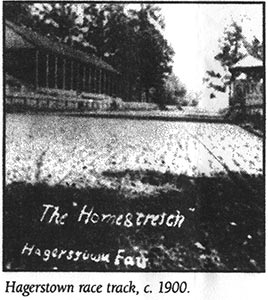 Designing
and building of the Richmond race track was entrusted to Robert A.
Howard, the County Surveyor. The race track was one mile in
length, built in two parallel stretches and joined by half circles.
The outside of the track on the approach to the curves and the
curves themselves were built sloping, higher on the outside than the
inside.
Designing
and building of the Richmond race track was entrusted to Robert A.
Howard, the County Surveyor. The race track was one mile in
length, built in two parallel stretches and joined by half circles.
The outside of the track on the approach to the curves and the
curves themselves were built sloping, higher on the outside than the
inside.
The Richmond track was the first in the country to be built in that manner. Mr. Howard secured a patent on this type of track.
Because of the new design and a spongy, springy soil which made for a fast track, it was declared the fastest track in the U.S. A few years later (circa 1910) Howard was contracted to design the 500 mile automobile race track in Indianapolis.
Wayne County of the 19th and early 20th centuries was well known throughout the country for its fine horse stock. Newspapers of the times report buyers coming from around the country to the Lackey Horse Sale in Cambridge City. The Hagerstown Fair had its last year in 1909. Torrential rains poured down, winds tore limbs from trees and many tents were overturned. The damage and flooding finished the fair which had suffered financial losses since 1907.
Although the fairgrounds were no more for Hagerstown, the race track was used as a training facility for race horses. The same was true of the race track on the south side of Cambridge City. It was on this track that Single G was trained, learning lessons which made him one of the finest racers in United States history.
Look for the exhibit of Single G if you go to the Wayne County Fair presented by the Alliance of Wayne County Museums. This is an organization representing several non-profit cultural and historical sites in the county. Wayne County has a rich history and excellent venues to show it. The Alliance includes the Wayne County Historical Museum, Levi Coffin House, Nettle Creek Valley Museum, Richmond Art Museum, Overbeck Museum, Huddleston Farmhouse Museum, Gaar House, Cope Environmental Center, Hayes Regional Arboretum, Overbeck House, Historic Centerville, Joseph Moore Museum and the Indiana Football Museum Hall of Fame.
Reprinted with Permission.
![]()
![]()
![]()
![]()
|
This jQuery slider was created with the free EasyRotator software from DWUser.com.
Need a powerful Flash slideshow creator with built-in iPhone/iPad/Android support? EasyRotator is supported by the XML Flash Slideshow v4 Software. OK |
This jQuery slider was created with the free EasyRotator software from DWUser.com.
Need a powerful Flash slideshow creator with built-in iPhone/iPad/Android support? EasyRotator is supported by the XML Flash Slideshow v4 Software. OK |
|
This jQuery slider was created with the free EasyRotator software from DWUser.com.
Use WordPress? The free EasyRotator for WordPress plugin lets you create beautiful WordPress sliders in seconds. OK |
This jQuery slider was created with the free EasyRotator software from DWUser.com.
Use WordPress? The free EasyRotator for WordPress plugin lets you create beautiful WordPress sliders in seconds. OK |
Featured Member
Community Photo
More Photos:
Wayne County | WayNet Albums
Did You Know?
Wayne County Fast Facts
| Location: | East Central Indiana, USA |
| Founded: | 1810 |
| Population: | 66,456 |
| Elevation: | 1,257 feet Highest Point in Indiana |
| County Seat: | Richmond |
| Local Time: | |
| Date: | |
| About Indiana: | IN.gov |
| Current Weather: |
Follow Us
Contact Us
| Email: | info@waynet.org |
| Phone: | 765.939.0857 |
| Mail: | 50 North 5th St. Richmond, IN 47374 |
| Director: | Board of Directors |
Stay in Touch
Sign up for WayNet News
- our e-newsletter.
Translate This Page
Join WayNet
About WayNet
Waynet, Inc. is a non-profit, 501(c)4 corporation that is fully-funded through memberships. Please support our members and let them know you located them via WayNet.org.
Top 25: popular pages & circulation information.
Our Recent Tweets
Copyright © Waynet, Inc. 2022, All Rights Reserved.| Policies
Directory | News | Discover | Find It Fast | Knowledge | To Do | Members

























